Web scraping can be quite a hassle if you don't have the right toolkit and, to make it worse, the landscape is flooded by many false promises.
We know how difficult and time-consuming it can be to go through all available web scraping tools to pick the best one. But we'll give you a hand on that! Below, we'll walk you through the most popular and reliable options.
Here's a quick overview:
| Web Scraping Tool | Best For | Pricing |
|---|---|---|
| ZenRows | Developers | 1,000 free API requests after signing up, then plans start from $49/month |
| Scrapy | Getting started in web scraping | Free open-source framework |
| ParseHub | Market researchers | Limited to five projects for free. After that, plans from $189/month. |
| Apify | Easy scraping of popular sites | $5 in credit for free. Plans from $49/month. |
| Mozenda | Marketers | 30-day free trial after contacting its sales department. Plans start at $99/month. |
| ScraperAPI | Cheap functionality | 1,000 API credits for free after signing up, then prices range from $49/month onwards |
| Octoparse | No-code data extraction | 14 days for free after signing up, then plans from $89/month |
| Import.io | E-commerce | 30 free days when contacting the sales department. After that, you start from $299 a month. |
List of Best Tools for Web Scraping
Now it's time to take a more detailed look at each of the top offers on the market.
1. ZenRows: For Developers
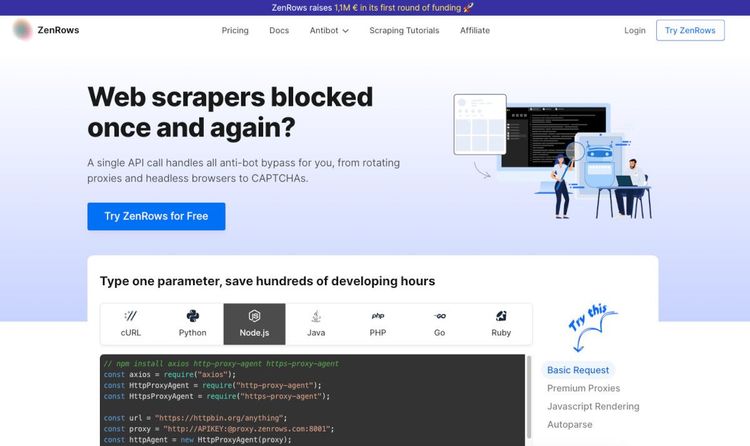
ZenRows is an API that comes with a powerful toolkit to get around all kinds of anti-scraping protections. It provides you with rotating premium proxies and headless browsing, among many other features.
It smoothly integrates with any programming language, including Python, NodeJS, Java, PHP, Go, and Ruby.
👍 Pros:
- Easy to use and with great documentation.
- Best web scraping library for anti-bot bypass.
- JavaScript rendering for human-like interactivity.
- Suitable for advanced web scraping.
- World-class support.
👎 Cons:
- You'll need a data parsing library.
Pricing
You get 1,000 API credits for free after signing up. Afterward, you can choose from four plans ranging from $49/month onwards.
2. Scrapy: For Getting Started in Web Scraping
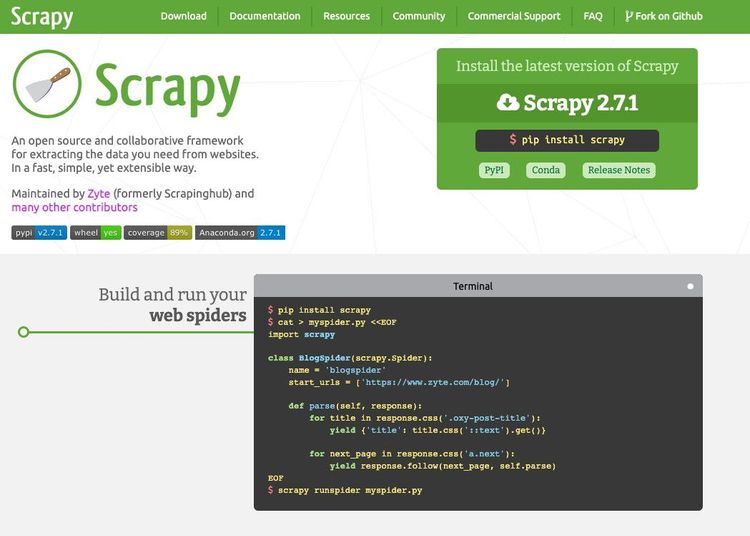
Scrapy is an open-source tool for automated web scraping. Having developers in mind, it supports asynchronous loading to scrape many pages at once, which will come in handy.
👍 Pros:
- Open-source library.
- Fast scraping of significant data volume.
- Export in different formats (JSON, CSV, XML).
👎 Cons:
- It can't handle JavaScript.
- Bypass features might fall short.
- Possible memory leaks.
Pricing
Scrapy is free to use but requires plug-in proxies bought from third-party providers, which can get expensive.
You might want to check out a Scrapy alternative.
3. ParseHub: For Market Researchers
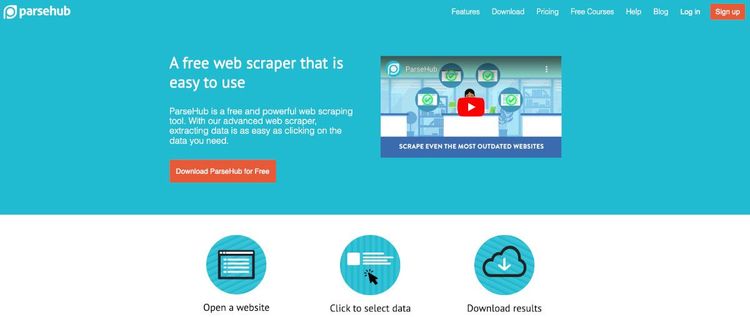
ParseHub is a web scraping tool that handles outdated websites and interactive pages, and you can integrate it with Tableau and Google Sheets. Furthermore, it offers rotating proxies to help avoid blocks, but they're available only with a paid plan.
👍 Pros:
- ParseHub scrapes AJAX and JavaScript pages.
- It allows downloading the data in JSON and Excel formats.
- There's a downloadable app for Windows, macOS, and Linux.
👎 Cons:
- The free scraping capacity is minimal.
- The paid plans are expensive.
- The custom scraper setup is complicated.
Pricing
This tool gives you 200 pages of data per run for five projects for free (one project typically equals one website), but the plan limits the available speed. Then, subscription plans start at $189/month.
4. Apify: For Easy Scraping of Popular Sites
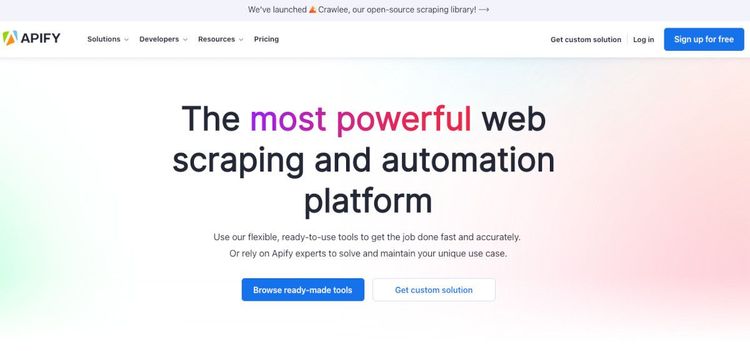
Apify is an online web scraper for popular websites that also comes with valuable integrations, such as Gmail, Slack and Google Drive. The free version allows a trial, but you must subscribe for full-fledged scraping.
👍 Pros:
- A collection of web parsers.
- Proxies to build new parsers.
👎 Cons:
- Hidden costs, as most features are charged separately per usage.
Pricing
You can give Apify a go with the free trial that offers $5 in platform credits, renewed monthly for nine team seats and 20 shared datacenter proxies. Paid options start at $49/month with 32 GB for each scraper.
5. Mozenda: For Marketers
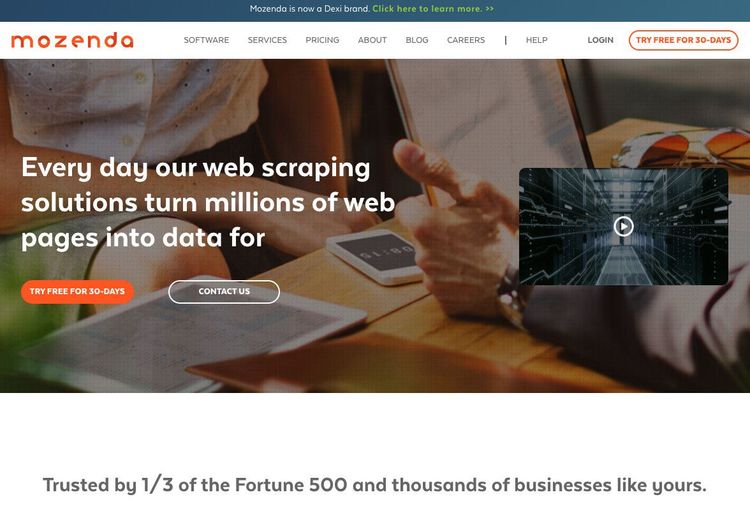
Mozenda is a Windows-based web scraping program with a point-and-click interface that works best for data analysts and marketers. Due to the spectrum of its functionality, it doesn't handle advanced web scraping nor allows stable anti-bot bypass.
👍 Pros:
- Point-and-click software for no-coding tasks.
- 30-day free trial.
- Many data export formats and possible integrations.
👎 Cons:
- Challenging to set up custom parsers.
- The web scraping tool isn't optimized.
Pricing
Mozenda offers a limited free trial that gives you 1.5 hours of web data extraction for one job. You need to contact customer service for details on its paid plans because there are no public prices.
6. ScraperAPI: For Cheap Functionality
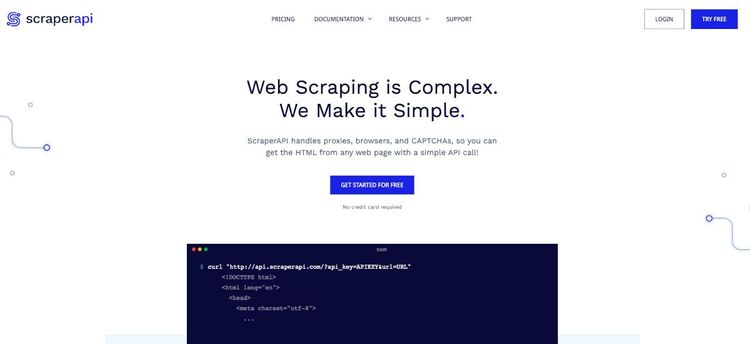
That is another web scraping package suitable for developers, able to fetch data from static and dynamic websites. Moreover, ScraperAPI pairs with any programming language and is packed with fundamental features for data extraction.
👍Pros:
- Proxy rotation, anti-bot bypass, and geo-targeting in all plans.
- Highly-rated customer support.
👎 Cons:
- Impossible to test without writing code.
- Key features are limited for the lower-priced plans.
Pricing
If you sign up, you'll get 1,000 API credits with a maximum of five concurrent connections. Paid options start at $49/month.
7. Octoparse: For No-code Data Extraction
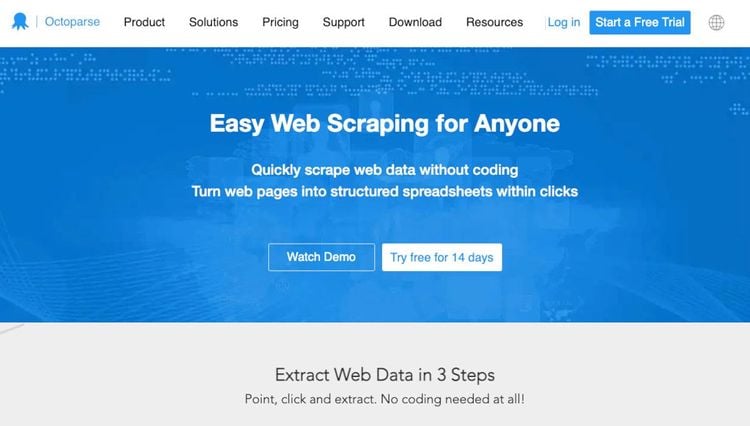
Octoparse is a no-code web scraping tool that offers cloud-based and downloadable platforms. Beginners praise this web crawler for its easy-to-use interface and the possibility to download data in different formats.
👍 Pros:
- Octoparse stands out among the no-code easy web scraping tools for beginners.
- It has rotating proxies, AJAX handling, and anti-bot bypass with paid plans.
👎 Cons:
- Limited features.
- Hard-to-find tutorials.
Pricing
The free trial plan isn't limited in time but allows only ten tasks that run with your IP and store a maximum of 10,000 rows per export. Pricing starts at $89/month and is limited to 100 tasks.
8. Import.io: For E-commerce
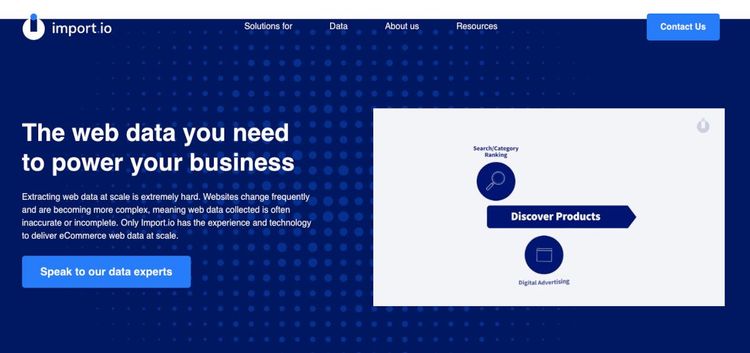
This enterprise-oriented web data scraping tool is excellent for e-commerce analytics. Without the need for coding skills, Import.io allows you to scrape thousands of e-commerce websites. However, its plans are six times more expensive than its competitors' offers.
👍 Pros:
- Highly-rated web scraping tool for e-commerce enterprises.
- Powerful no-coding program.
- It integrates with data analytics software and BI tools.
👎 Cons:
- No transparent pricing.
- A demo is only available when contacting the sales department.
- The subscription-based policy doesn't allow idle periods.
Pricing
Although the tool doesn't reveal its prices, some sources mention they start at $299/month. You'll have to contact a sales team representative to get a quote.
What to Know to Pick the Right Web Scraping Tool
Once you got to know the best web scraping tools, here comes some additional information to help you decide.
How to Choose a Web Scraping Tool
Choosing the right web scraping tool may be challenging, even if you're clear on your abilities and goals. Here are some essential factors to consider about committing to a web scraping tool subscription:
- Room for scaling up: Some tools are good at small tasks or have a low query load. But most likely, the more your business grows, the higher scraping capacity you'll need. You might want to avoid tools that set a limited bandwidth or charge extra for multithreading.
- Check the price: Many web scraping SaaS are secretive with their pricing policy. Only services confident in the quality they provide allow immediate access to a trial and show the price.
- Anti-bot solutions: Some tools deal with blocking systems better than others. The less attention a tool pays to anti-scraping measures, the greater the chances of getting blocked.
- Scraping scope: Many tools are subscription-based, meaning they'll also charge idle periods. If you perform only occasional web scraping tasks or small volumes, you'll need a flexible web scraping tool.
Types of Web Scraping Tools
As different tools are designed for diverse purposes, you need to be aware of their types. That will help you find the option best aligned with your goals.
Let's dive in!
Web Scraping Libraries and Frameworks
These are open-source tools that can be set above your application, integrating with specific programming languages and requiring coding skills. Examples of web scraping frameworks are Scrapy, pyspider, Beautiful Soap, and Goutte.
Web Scraping Software
These tools are often cloud-based, no-code and tend toward integration. Some examples are Import.io and Mozenda.
Web Scraping APIs
Web scraping APIs are developer-oriented and have the most advanced anti-blocking features. An example of this type is ZenRows.
Desktop Scraping Applications
Desktop suites are professional web scrapers you can install on your computer to execute tasks from a local environment. The advantage is that it's often free or comes with a one-time license.
Downloadable scraping applications are suitable for running SEO-related tasks, like crawling web pages, finding issues, and extracting URLs, slugs, and keywords.
If you want some good examples of such software, you can try ScrapeBox or ScreamingFrog.
No-code Browser Scrapers
These are usually lighter versions of professional software and APIs. You can install them as a browser extension, and sometimes they come with a dashboard. Easy to use but with limited functionality.
Instant Data Scraper and Webscraper.io are good options to test out.
Use Cases of Web Scraping Tools
You can make a web scraper work for you in many ways, but let's consider some common examples.
- Open data collection: Raw data forms warehouses, sets, and lakes for data analysis. You can crawl keywords or topics to understand a given context or trend.
- Price tracking: With price monitoring software, you'll automate the process of tracking fluctuations in your competitors' pricing.
- Lead generation: You create lists for marketing and sales by crawling public pages on social media or specific sites.
- News monitoring: If your business relies on media coverage, you'll easily know who says what about your brand, industry, and competitors.
Conclusion
Now that you've gone through our selection and comparison of the top web scraping tools available on the market and some considerations to choose the right one, it's your time to test them out.
Bear in mind that many websites have some protection against scraping, so prioritizing solutions with strong anti-bot bypass, like ZenRows, is worth of consideration.
Did you find the content helpful? Spread the word and share it on Twitter, or LinkedIn.